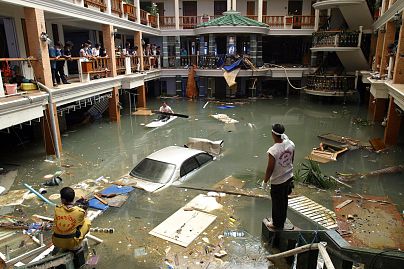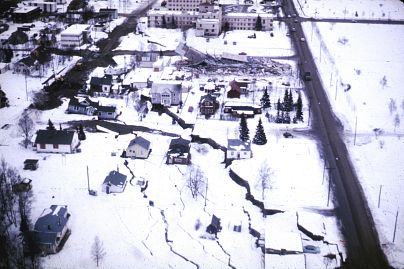The giant waves can move at speeds of up to 500 miles an hour and reach heights of hundreds of feet.
Tsunamis are giant waves or rapid rises in sea level. They're rare events, occurring on average about twice a year somewhere in the world — about once every 15 years for the most destructive tsunamis, which can cover an entire ocean basin.
Tsunamis travel at speeds of up to 500 miles an hour in the open ocean and rise to heights of several hundred feet as they come ashore. They can cause widespread devastation in coastal areas — especially in the aftermath of a large earthquake.
Tsunami means "harbor wave" in Japanese. Because the undersea earthquakes that trigger most tsunamis are relatively common off Japan's coasts, it is especially vulnerable to these coastal disasters.
Other vulnerable areas include Alaska, the Pacific Northwest and Hawaii.
About 80 percent of tsunamis occur in the Pacific Ocean, caused by earthquakes along the edges of the undersea tectonic plates known as the Pacific Ring of Fire.
In the past, tsunamis were sometimes called "tidal waves." But that name fell out of favor because the waves have nothing to do with ocean tides.
What causes tsunamis?
The main cause of tsunamis are earthquakes that trigger sharp movements of the seafloor. In some cases landslides can also cause tsunamis.
As the energy of an earthquake on the seafloor is transferred to the water above, it causes waves to form. Some quakes cause tsunamis that spread out in all directions. Others tsunamis propagate in a particular direction, depending on how the seafloor was disturbed.
Tsunamis can strike coastal areas within minutes or hours, depending on how far an undersea earthquake is from shore.
When tsunamis move from relatively deep water into shallow coastal water, they're sometimes amplified by the shape of the seafloor and land features in the area. As a result, a wave that is relatively small in the open ocean can grow tremendously in size and destructive power when it hits land.
Just how devastating can tsunamis be?
The Indian Ocean tsunami in 2004 killed an estimated 225,000 people in 14 countries, including India, Sri Lanka, Indonesia and Thailand. It was caused by a powerful earthquake near the island of Sumatra, which created waves up to 100 feet high that sped to coastlines around the region.
The tsunami that struck Japan in 2011 was caused by an undersea quake off the country's eastern coast. The quake triggered waves of up to 133 feet along parts of the coast, causing more than 15,000 deaths and damaging the Fukushima nuclear plant.
The most powerful tsunami in the U.S. was caused by a magnitude 9.2 earthquake in Alaska in 1964. It killed 139 people, most not by the quake itself but by the resulting tsunami, which destroyed many buildings along the coast and set fire to oil storage tanks.
Emily Roland, a marine seismologist at the University of Washington in Seattle, said Alaska and the Cascadia region in the Pacific Northwest are especially vulnerable to tsunamis caused by earthquakes near their coasts, while the islands of Hawaii are at risk from tsunamis occurring anywhere in the Pacific Ocean.
How can you protect yourself?
People living in coastal areas should be aware of the risk posed by tsunamis — and should heed tsunami alerts, which in the U.S. are issued by the National Weather Service of the National Oceanic and Atmospheric Administration (NOAA).
If you live in a coastal area or are visiting one, know in advance the evacuation routes and safety zones. Tsunami safety zones are typically found on higher ground. If you don't have time to reach one, the upper floors of buildings may be safer than ground level. As a last resort, you could climb a tree or tall structure to avoid the water.
"The main message is to educate yourself whether you are in a region of higher tsunami risk — understanding the established evacuation routes and the safe zones for evacuating is the best thing to do," Roland said.
The National Weather Service issues tsunami warnings for coastal areas to people who sign up for its wireless emergency alerts on cellphones, as well as through radio and television stations, and by email, through NOAA websites, and on social media like Twitter and Facebook.
But "if you feel an earthquake and you live in a coastal zone, it may not be too early to start moving to higher ground right away — you don't need to wait for a tsunami warning," Roland said.













